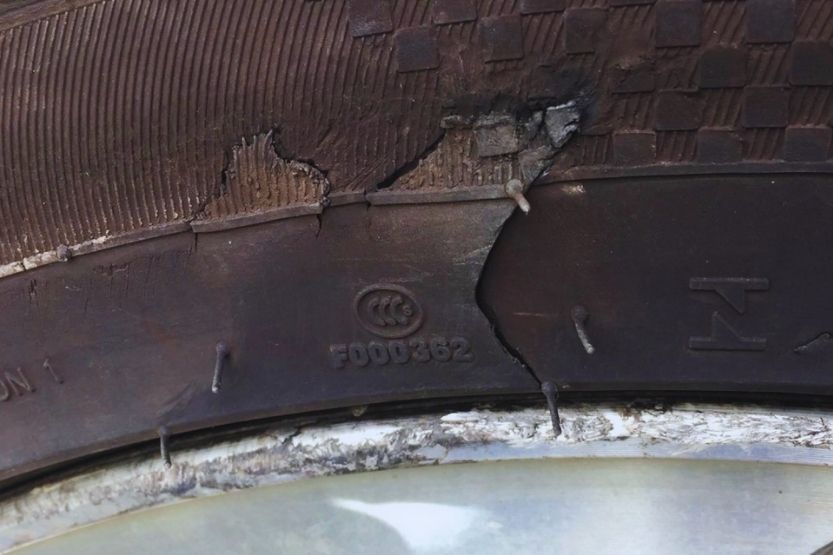The tire sidewall is one of the most important components of a tire. Once it gets damaged, it is hardly repairable. But when can you say that the tire sidewall damage is too much?
Once a tire sidewall damage reaches the threads, don’t attempt to repair it anymore because the damage has already affected the structure of the whole tire. If the tire sidewall only has a single bubble or has tiny punctures, do not attempt to repair it. No matter how minor the damage seems, it impacts the tire’s whole structure.
Read on to learn more about tire sidewall damage, including how to tell that it is already irreparable.
Tire Sidewall Damage – How Much Is Too Much? When to Repair?

Don’t attempt to repair a tire sidewall if the damage has already reached the threads. If you notice tiny punctures or even just a single bubble, don’t attempt to repair it too.
These damages have most likely affected the entire structure of the tire. This means that it can’t be repaired anymore. Trying to do so and using the tire once again is not a safe practice at all.
A tire is made of various types of high-quality hardened rubber designed to ensure its durability. The tire sidewall is one of its most essential components. If it wears, it is most likely not repairable anymore.
Do not attempt to drive your car with tire sidewall damage because it is not safe. The damage only gets bigger. You’re only putting yourself and others at risk.
What Is a Tire Sidewall Damage?
When there’s tire sidewall damage, the damage is basically on the side of the tire and not on the tire tread. Typically, it results from minor accidents or if you drive close to the road’s curb. It can also result from sharp objects on the road.
Tire Sidewall Damage Causes
There are several reasons why tire sidewall damage occurs. Some of these are the following:
- Factory Defects
- Tire Age
- Overloading
- Tire Wear
- Under Inflation
- Driving on a Flat
Let’s briefly discuss them:
1. Factory Defects
Indeed, you have already heard of tires with factory defects. Popular tire manufacturers also have isolated cases of factory defects.
Sadly, some tire manufacturers skip necessary processes, such as the speed rating test. If tires do not undergo this test, the makers would not know how durable their products are before rolling them off the factory.
Some of their tires may be susceptible to overheating, impacting the sidewall, especially when driving at high speeds.
2. Tire Age
Tires are designed to weather rough road conditions. But they are not intended to last forever. Their durability, strength, and elasticity wear out, too, depending on your driving habits and how often you use your car.
Tires typically last for about 8 to 10 years, according to tire makers. After several years, their rubber components eventually become dry and brittle. The inner plies that keep the tire intact start to weaken, and all other parts fall apart.
3. Overloading
Vehicles have a prescribed limit. This information is always provided by car manufacturers and is even included in the list of specs. That way, you will avoid overloading your car.
An overloaded vehicle places too much stress on the suspension system and the tires. It causes the tires to flatten. The tires can explode due to air pressure buildup on the sidewall and the heat generated by friction.
Overloading also causes the vehicle to wiggle as you drive.
4. Tire Wear
If a tire has significant wear, it tends to overheat fast, resulting in a blowout. What’s worse is if the reinforcement, which maintains the shape of the tires, starts to show up at the sidewall. The tire sidewall will most likely get damaged if it accidentally hits a curb.
5. Under Inflation
It is normal for tires to deflate, so they need regular air pressure checks. This is not only to prolong the life of your tires. More than anything else, it is for your safety and the safety of your passengers.
6. Driving on a Flat
Tire sidewall damage results from driving on a flat. Driving your car with a flat tire further flexes the internal cord more than normal. This then compromises the tire casing to an unknown extent.
Types of Tire Sidewall Damage

There are different types of tire sidewall damage. Some of these are the following:
- Bubble
- Deep and Huge Abrasions
- Small Chunk of Tire Sidewall Is Missing
Let’s briefly talk about these tire sidewall damage types:
1. Bubble
A sidewall bubble is tire damage from hitting the curb. It also results from driving extremely fast over speed bumps or hitting a pothole. It’s quite easy to notice a bubble as a bulge protruding on the tire’s side.
2. Deep and Huge Abrasions
Similarly, an abrasion is tire damage from hitting the curb. It also results from running a deep pothole. The size and appearances of abrasions vary. It can look like rough scapes or have a slash-like appearance. But even if the bruises are small, they should not be ignored.
3. Small Chunk of Tire Sidewall Is Missing
The sidewall can be chipped off from the tire. If this happens, the inner cords or threads will get exposed. This should not be ignored because those threads hold the structure of the whole tire.
How to Repair Tire Sidewall Damage
Significant damage to the tire sidewall can either be big or small. Most of the time, tire sidewall damage can’t be repaired. In which case, it is always advisable to have your tire replaced. But what if there is only a minor rip in the tire sidewall?
There are instances when minor tire sidewall damage can still be repaired. But you need to assess the damage thoroughly to ensure that it is indeed repairable. A puncture that measures less than ¼ inch may still be considered repairable.
So, assuming that the damage is only very minor, the best way to fix it is by using rubber cement. This type of cement is commonly used in the tire industry and is available in auto shops.
Here are the steps for fixing minor tire sidewall damage:
- Buy a Tire Plug Kit and Rubber Cement
- Check the Damage
- Roughen the Hole’s Surface
- Thread the Plug Strip
- Apply Rubber Cement
- Insert the Cement-Coated Plug Strip
- Refill the Tire with Air
- Cut the Plug Strip
Let me briefly explain each item:
1. Buy a Tire Plug Kit and Rubber Cement
The first thing to do is buy a tire plug kit and a tube of rubber cement. It is recommended that you always store these materials in your vehicle’s trunk for emergency purposes.
2. Check the Damage
Check the tire sidewall damage once again and remove the culprit using pliers. When you do this, the air from the tire would rapidly release. This means that you have to apply the plug fast.
3. Roughen the Hole’s Surface
The next step is to roughen the hole’s inner surface using a T-handle reaming tool, which is included in the plug kit you bought. Jam the tool into the hole, work it up and down, and rotate repeatedly.
4. Thread the Plug Strip
Using pliers, thread the plug strip into the insertion tool’s eyelet.
5. Apply Rubber Cement
Apply the rubber cement to the plug strip and the sidewall hole.
6. Insert the Cement-Coated Plug Strip
The next step is to insert the cement-coated plug strip into the hole carefully. You will most likely need to exert some force to do this efficiently. Press it hard so that the plug will get into the hole successfully. When it reaches about an inch into the hole, you can pull it up using an insertion tool.
7. Refill the Tire with Air
By this time, you are done patching the minor damage. But you have to check if you have patched it successfully. To do this, you have to refill the tire with air. Then, use water with soap to check if the air still pops out of the hole. If it does, it means that you did not correctly do it.
In this case, you probably need to seek assistance from a professional. Let them assess if your tire can still be repaired or if it needs replacement.
8. Cut the Plug Strip
If, after doing step 7, you notice that there are no more leaks, start cutting out the plug strip. Then, make sure to clean the area from any excess rubber cement.
Again, how much tire sidewall damage is too much? When you see that the tire sidewalls’ threads or cords are already exposed, you should replace your tires immediately. Note that you should not treat this damage by using plugs or patches.
Is It Safe to Use a Tire with Repaired Tire Sidewall Damage
Once the tire sidewall shows damage, whether minor or significant, it has already lost its integrity. It is always recommended to replace your tire immediately instead of merely having it repaired.
It is quite hard to assess tire sidewall damage. Sometimes, even if it looks pretty minor, it can cause the tire to fail. This is dangerous, especially while driving in the middle of the road. It is not only risky for you as a driver. But it is also risky for your passengers and everyone else on the road.
You should be aware that there are times when a repaired tire sidewall can still blow up at any time. Repairing the damage using rubber cement may work occasionally. But be mindful that your tire’s performance will never be the same as before. Your tire’s quality is already compromised.
How to Avoid Tire Sidewall Damage

There are driving conditions when you can’t avoid encountering tire sidewall damage. But there are also ways to prevent it from happening. Some of these are the following:
- Regular Air Pressure Check
- Follow Recommended Vehicle Load and Speed Ratings
- Avoid Road Hazards
- Have Your Tires Checked by Experts
Let’s briefly discuss them all:
1. Regular Air Pressure Check
Have your tires’ air pressure checked regularly. By regular, this means at least once a month. It can be less than a month, especially if you think they are already deflated.
You must perform a cold tire pressure reading too. This is because air pressure also depends on temperature changes.
It is ideal for pairing a tire pressure gauge with a portable inflator. The power outlet of your vehicle can power this. You can store these tools in the trunk as they don’t eat up a lot of space anyway.
2. Follow Recommended Vehicle Load and Speed Ratings
It is important to be familiar with the fundamentals of tire information reading. You have probably noticed codes embossed on your vehicle’s tires. They don’t just tell you the size of your tires; they also tell you their speed rating limit.
Check the tire information sticker on the door frame of your vehicle too. It informs you of your vehicle’s load capacity and the required tire air pressure in psi.
You will surely avoid encountering tire damage earlier than expected if you strictly follow those recommendations.
3. Avoid Road Hazards
Before traveling, it is recommended to plan your route. Avoid areas with road constructions since you might hit pointed objects such as nails or sharp stones. These can result in abrasions in the tire sidewall.
Make sure always to be mindful of the road. Avoid potholes and maneuvering near a curb. As much as possible, avoid situations that might scratch your tire sidewall.
4. Have Your Tires Checked by Experts
Of course, you can personally check and assess your tires for any damage. But if it already involves your tire’s sidewall, it is always best to ask for assistance from tire technicians and experts. They are the ones who can truly evaluate the condition of your tires.
Frequently Asked Questions – How Much Sidewall Tire Damage Is Too Much?
Here are some frequently asked questions about tire sidewall damage:
Can I Use a Tire with Sidewall Damage?
It is not safe to drive a car with tire sidewall damage. Even if you think the damage is small, it will only become bigger as you drive. This could lead to sudden tire blowouts, putting yourself and others on the road at risk.
What Is Considered Sidewall Damage?
A tire sidewall damage refers to any issue encountered concerning the tire sidewall. No matter how minor the damage is, you should not ignore this as it can eventually result in complete tire failure.
When Should You Replace Tire with Sidewall Damage?
If there is extensive sidewall damage, you have to replace your tire because you cannot repair it anymore.
If the damage is less than a quarter of an inch, thoroughly evaluate if you can still repair it. But, in any case, the best solution to any minor or significant tire sidewall damage is to replace the whole tire.
Can Sidewall Damage Cause a Blowout?
Yes, sidewall damage can result in a blowout. Overinflation of the tire can result in bulges or bubbles in the sidewall, which can cause a blowout. If you hit a curb, this also leads to bulges or bubbles since it will affect the tire’s inner structure. This is commonly known as an impact break.
Suffice to say that you should always check your tires for any bulges or bubbles. If you find it hard to assess your tire’s condition, immediately bring your car to a tire technician or expert.
How Long Can You Drive on a Ripped Tire?
There are cases when you can still drive even with a hole or rip in the tire sidewall. But you can only do this for a limited period. Also, you have to drive real slow because it can compromise your handling and braking.
If you have to drive on a ripped tire, car makers recommend driving not more than 25 miles.
Can Hitting a Curb Mess Up a Tire?
Yes, hitting a curb can damage your tire, including the suspension system. Even if you are driving real slow, hitting a curb can still damage your tires.
Conclusion – Tire Sidewall Damage – How Much Is Too Much? When to Repair?
It is best to replace your tires once the sidewalls are damaged. Any damage that has reached the threads is considered a major one. This is considered major damage if you only notice tiny punctures or a single bubble.
In which case, don’t attempt to have still your tire repaired. Instead, you should go and replace your tire immediately.
It is hard to assess minor damage. This is because the damage can get bigger as you use your vehicle. You have the choice to repair it, but it will not bring back the original quality of your tire.
The tire sidewall is one of the most important components of the tire. So, if it gets damaged, the only best solution is to replace the whole tire.
Read next:




![How Much Does Paintless Dent Repair Cost? [Full Guide] how much does paintless dent repair cost](https://roadsumo.com/wp-content/uploads/2022/05/how-much-does-paintless-dent-repair-cost-150x150.jpg)
![Scratched Rims Repair Cost [How Much to Fix a Scratched Rim?] Scratched Rims Repair Cost](https://roadsumo.com/wp-content/uploads/2021/10/scratched-rims-repair-cost-150x150.jpg)

![Read more about the article Nail in Tire [How to Repair? What to Do?]](https://roadsumo.com/wp-content/uploads/2021/04/nail-in-tire-300x200.jpg)
![Read more about the article Walmart Tire Rotation Cost [What Does Walmart Charge?]](https://roadsumo.com/wp-content/uploads/2021/07/walmart-tire-rotation-cost-300x200.jpg)
